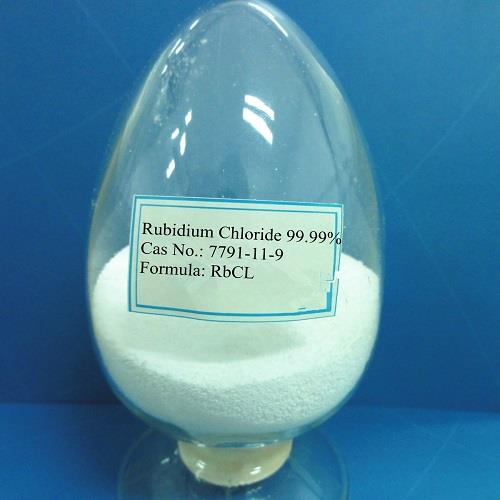Description
Rubidium chloride (7791-11-9) is a kind of alkali metal halide consisting of rubidium and chlorine. It has applications in various kinds of fields. It can be used as a gasoline additive and an excellent non-invasive biomarker. For example, it can be used as a radioactive isotope to trace many kinds of biological processes such as measuring the coronary collateral blood flow. It can also be used for the preparation of competent cells in molecular cloning. In addition, it is a kind of antidepressant which is capable of increasing the dopamine and norepinephrine levels. The effect is also related with the stimulation of rubidium chloride on the generation of nitric oxide.
Uses
Rubidium chloride is used in preparing rubidium metal and many rubidium salts. Also, it is used in pharmaceuticals as an antidepressant and as a density-gradient medium for centrifugal separation of viruses, DNA, and large particles. Other applications are as an additive to gasoline to improve its octane number and as a catalyst.
Preparation
Rubidium chloride is prepared by adding hydrochloric acid to a solution of rubidium carbonate or hydroxide. The solution is evaporated to obtain welldefined colorless cubic crystals of rubidium chloride
RbOH + HCl → RbCl + H2O
Rb2CO3 + 2HCl → 2RbCl + H2O + CO2
References
[1] Zhen-Yu, L. I., X. U. Kai-Lin, and X. Y. Pan. "Rubidium chloride method for the preparation of competent E. coli cells." Acta Academiae Medicinae Xuzhou (2004).
[2] Bernard, Jean Rene, and Jean Nury. "Method of dehydrocyclizing aliphatic hydrocarbons." U.S. Patent No. 4,104,320. 1 Aug. 1978.
[3] Quattlebaum, F. W., R. F. Edlich, and C. W. Lillehei. "Measurement of coronary collateral blood flow using radioactive rubidium chloride." Surg Gynecol Obstet 129.5(1969):1034-1038. PMID:
5824267[4] Kordjazy, Nastaran, et al. "Elevated level of nitric oxide mediates the anti-depressant effect of rubidium chloride in mice." European journal of pharmacology 762 (2015). DOI:
10.1016/j.ejphar.2015.06.030
Chemical Properties
Rubidium chloride is an alkali metal halide, chemical formula RbCl, white crystalline powder; lustrous. When heated it decrepitates, melts, and volatizes. soluble in water, slightly soluble in alcohol. In the gaseous state, RbCl is a diatomic molecule with a bond length of about 2.7868A. The bond length increases to 3.285?A in the cubic system, showing a high ionic coordination number in the solid state.

Rubidium chlorides is a source of rubidium metal. Rubidium is usually prepared by the thermal reduction of rubidium chloride.When rubidium chloride and calcium are heated together in stoichiometric proportions at 900-1000°C under a pressure of about 0.02 torr, rubidium distills over.
Uses
It is used in testing for perchloric acid in laboratories, and is a source of rubidium. Rubidium chloride is used as a catalyst and additive in petrol. It has been employed to prepare molecular nanowires for nanoscale devices. Thin layer of rubidium chloride enhance the attributes of organic light-emitting diodes. Rubidium chloride also plays an essential role for enhancement in the memory storage property. It is an excellent non-invasive biomarker, and used in biomedical research.
Definition
ChEBI: Rubidium chloride is an inorganic chloride composed of rubidium and chloride ions in a 1:1 ratio. It has a role as an antidepressant and a biomarker. It is a rubidium molecular entity and an inorganic chloride.
Application
Rubidium chloride (RbCl) , an alkali halide may be used to dope L-alanine hydrogen chloride monohydrate single crystals to alter its dielectric properties. Rubidium chloride has been used as a marker in studies on several herbivorous insects.
Rubidium chloride is used as a catalyst and additive in gasoline. In materials science, RbCl has been used to prepare molecular nanowires as potential precursors of nanoscale devices. In chromatography, RbCl and other univalent salts have been studied for their influence on the capillary electrophoretic separation of amino acids labeled with 3-(4-carboxybenzoyl)-quinoline-2-carboxaldehyde. RbCl is utilized in the transfection of bacteria. RbCl has been used to investigate the gating and permeability of ion channels produced by botulinum neurotoxin types A and E in membranes from cultured PC12 cells.
Toxicology
The chemical, physical and toxicological properties of rubidium chloride have not been thoroughly investigated and recorded. Acute Effects: Inhalation: May cause irritation to the respiratory system. Ingestion: May cause ataxia and hyperirritability.
Purification Methods
Crystallise it from water (0.7mL/g) by cooling to 0o from 100o. Its solubility in H2O is 77.3% at 0.6o, 90.3% at 70o and 147% at boiling point. [D.nges in Handbook of Preparative Inorganic Chemistry (Ed. Brauer) Academic Press Vol I p 951-955 1963.]





